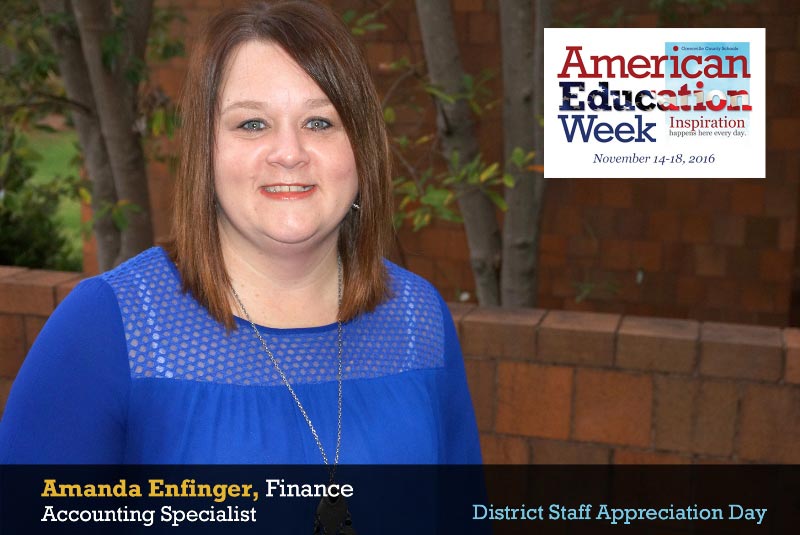American Education Week - District Staff Appreciation Day
- American Education News Release
- American Education Week - Monday - School Support Staff Appreciation Day
- American Education Week - Tuesday - Transportation Staff Appreciation Day
- American Education Week - Wednesday - Educator Appreciation Day
- American Education Week - Thursday -Operations/Maintenance Appreciation Day

Amanda Enfinger, Accounting Specialist - Finance
Getting products delivered to schools in a timely manner is of utmost importance to Amanda Enfinger, Accounting Specialist in the Finance Department. “I enjoy helping school secretaries get their job done so they can then help their principals, teachers and students,” she explained.
Enfinger is responsible for approving all requisitions for schools so they can request purchase orders and buy their products. “I also review all the P-Card transactions for schools, and train one-on-one with new secretaries to make sure they know their job functions from start to finish,” she said.
Enfinger enjoys helping others and providing quality service to schools. “Whether they need Chromebooks, nurse supplies, Band-Aids, masks, or a specific chair in the library, I am here to make sure schools can provide innovative and exciting environments for students to learn,” said Enfinger.
 Natasha Griffin, School Psychologist - Special Education Services
Natasha Griffin, School Psychologist - Special Education Services
School psychologists play an integral role as part of a school’s Assistance Team, or A-Team. Natasha Griffin, one of about 30 GCS school psychologists, serves on the A-Team at four schools to problem-solve for students exhibiting learning, behavioral, and/or social difficulties and to develop interventions and monitor progress.
School psychologists also help determine if students have a disability and if they are eligible for special education services. “I work with students one-on-one, so I often get to see what they can do in an ideal situation and then, when we meet with the teachers, I explain what I was able to do with the student and give them suggestions of interventions and accommodations to help the student in the classroom," she said. Griffin added that it is extremely important to involve and consult with parents, teachers, and administrators when evaluating a student’s needs.
“I recently worked with a student with learning difficulties and attention problems. The evaluation showed that the student had good ideas but struggled to appropriately write them on paper.” she explained. “I suggested if the student is not being tested on his ability to write, he can tell the teacher what he is thinking, rather than writing it on paper. It gives the teachers a different way to assess what the student knows," she added.
 Leroy Hamilton, Director of School Administrative Support
Leroy Hamilton, Director of School Administrative Support
In his 40-plus years with Greenville County Schools, Mr. Hamilton has served as teacher, social worker, administrative assistant, principal, executive director, education construction liaison, assistant superintendent, and interim deputy superintendent.
He has the ability to see the big picture in every position he holds. His attention to detail and problem-solving abilities make him the go-to person to solve a school or district-level problem.
Recognized for taking copious notes and thoroughly investigating a situation, his attention to detail is unmatched. Hamilton guided Hillcrest High through the growing pains of an overcrowded building into a new state-of-the-art facility; he led the meticulous process of naming Bell’s Crossing Elementary School to reflect the area’s rich history; and he assisted the district with one of the largest school construction projects in the nation.
 Randolyn Harmon, Director - Title I Programs
Randolyn Harmon, Director - Title I Programs
“My role is to help our schools develop a Title I plan that will be of service to our students,” said Randolyn Harmon, director of Title I Programs. “Title I funding, which is a $25 million grant, allows us to focus on identified needs when we’re looking at the whole child,” she said. “For example, we can provide additional academic resources for students and teachers, and social work or nursing services to identified at-risk students. We want to ensure that they have the resources they need so they can gain academic excellence.”
Greenville County Schools has 15 elementary schools, three middle schools, and one charter school that receive Title I funding. “When you work with at-risk students, it is good to know that Title I funds can be used to help children close the achievement gap,” she said.
For example, Title I funds are used to help parents better understand how they can help their children with homework, reduce class size, implement before and after school programs, and conduct small group intervention.


